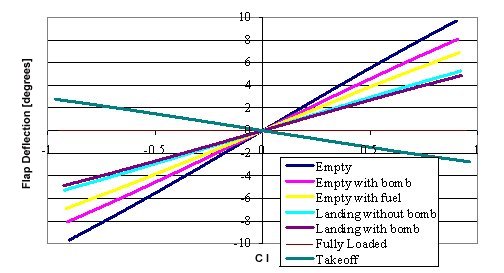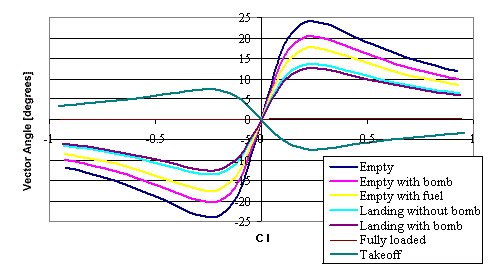|
||||||||||
|
|
||||||||||
|
||||||||||
|
|
||||||||||
|
|
|
||||||||||||||||||
|
Static Longitudinal Stability:Two key factors which determine the aerodynamic center of a wing are the geometry of the planform and the aerodynamic center of the airfoil. Since the Storm Shadow has been designed without traditional tail control surfaces, the ability to control the aerodynamic center is limited to these fundamamental characteristics of wing design. The selection of a proper airfoil is discussed here. As also discussed in the aerodynamics section, the geometry of the planform was largely determined by the sweep angle and distance between engines. After careful consideration of the aerodynamic, configurational, and stability effects of these parameters, a sweep angle of 55° and an engine spacing of 54 in were selected. These values and the airfoil aerodynamic center locate the aerodynamic center of the entire aircraft 8.3 ft behind the aircraft nose. To be stable, the center of gravity (CG) must be at or forward of this location at all times. Though not easy to accomplish, the Storm Shadow is stable in all configurations except takeoff. Because of this, a fly-by-wire flight control system with a computer controlled feedback loop has been implemented. Control Surfaces:Pitch, or longitudinal, control is typically provided by elevators on a horizontal control surface. Since the Storm Shadow lacks a horizontal tail, both trailing edge flaps and thrust vectoring nozzles are provided to achieve pitch control. The flaps are sized as 20% of the outboard wing chord yielding a flap effectiveness of -0.00505 change in lift coefficient (CL) per degree of deflection. Using the flap effectiveness and the drag polars, the flap deflections needed to maintain steady flight at various CL values were claculated. These trim curves, shown below, can be compared to the same deflections needed if thrust vectoring were used to trim the aircraft.

Flap deflection to trim

Thrust vector angle to trimSince the thrust vectoring is more effective at high CL values, the nozzles would likely be used during takeoff and landing when the flaps would be needed to increase lift. Yaw control in needed to turn the aircraft, and to maintain straight flight in a crosswind or when one engine is inoperative (OEI). This control is provided by a rudder in a traditional vertical tail assembly. Since the Storm Shadow does not have a vertical tail, a different method had to be found. Inspired by the B-2 stealth bomber, a drag rudder arrangement was selected. Further strengthening this decision are a series of NASA wind tunnel experiments on an aero-diamond wing planform showing that drag rudders are more effective than a typical fin and rudder combination. The rudders may also be used for braking during landing. Roll control is provided by the outboard flaps which also act as ailerons. Since these flaps have the longest moment arm, they are most effective in producing a roll. Leading edge flaps are also provided to be used in conjuction with the trailing edge flaps to produce a cambered effect. By adjusting both sets of flaps, the aircraft can be trimmed at any CL while minimizing drag. The leading edge flaps may also be used to alleviate leading edge separation at high angles of attack.

Control surface configuration |


|
Aircraft | Design | Ask Us | Shop | Search |

|
|
| About Us | Contact Us | Copyright © 1997- | |||
|
|
|||